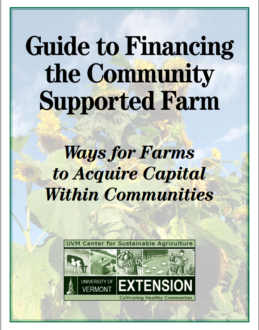Since it is not always easy to obtain loans from traditional financing sources, farmers are exploring alternative funding opportunities to meet their needs. Unconventional financial arrangements, which are new to the agricultural sector, include a variety of mechanisms where financial transactions take place between the community and farmers. Community financing, represented by both monetary and social capital, is transferred from the community to farm operations, allowing farmers to benefit from a supportive community. The guide provides eight specific examples of finance mechanisms being used by Vermont farmers today to finance their operations and investments. It also includes case studies of four farmers in Vermont that are using the various strategies to support their farm businesses.
Want more information? See the related SARE grant:
- Guide to Financing the Community Supported Farm (ONE11-146)
This material is based upon work that is supported by the National Institute of Food and Agriculture, U.S. Department of Agriculture through the Sustainable Agriculture Research and Education (SARE) program. Any opinions, findings, conclusions, or recommendations expressed in this publication are those of the author(s) and should not be construed to represent any official USDA or U.S. Government determination or policy.
